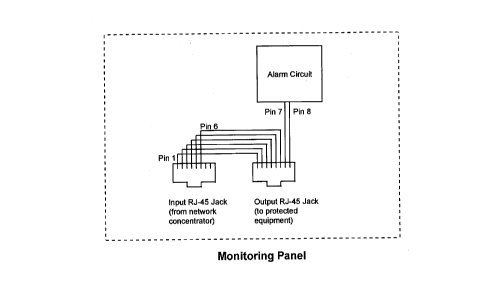Some of the information on this Web page has been provided by external sources. The Government of Canada is not responsible for the accuracy, reliability or currency of the information supplied by external sources. Users wishing to rely upon this information should consult directly with the source of the information. Content provided by external sources is not subject to official languages, privacy and accessibility requirements.
Any discrepancies in the text and image of the Claims and Abstract are due to differing posting times. Text of the Claims and Abstract are posted:
| (12) Patent Application: | (11) CA 2183106 |
|---|---|
| (54) English Title: | NETWORK PC SUPERVISED ALARM SYSTEM |
| (54) French Title: | SYSTEME D'ALARME ET DE SURVEILLANCE POUR MICRO-ORDINATEURS EN RESEAU |
| Status: | Dead |
| (51) International Patent Classification (IPC): |
|
|---|---|
| (72) Inventors : |
|
| (73) Owners : |
|
| (71) Applicants : |
|
| (74) Agent: | |
| (74) Associate agent: | |
| (45) Issued: | |
| (22) Filed Date: | 1996-08-12 |
| (41) Open to Public Inspection: | 1998-02-13 |
| Availability of licence: | N/A |
| (25) Language of filing: | English |
| Patent Cooperation Treaty (PCT): | No |
|---|
| (30) Application Priority Data: | None |
|---|
A method and system for monitoring equipment in a network environment are provided. Such equipment
could be, but may not necessarily be, computers, printers, monitors, and other computer hardware. The
system incorporates existing network cabling in the building which must contain a plurality of conductors,
of which, at least two conductors must not be utilised by the existing network protocol. The system uses
the two unused conductors to create a current loop which can be monitored from a central location. A
specific resistance is fastened to the monitored equipment, and a voltage comparator at the central location
activates an alarm if the resistance changes. The system is designed so that it can be installed onto existing
network structures using common network patch cables, and without permanently defacing the monitored
equipment.
Note: Claims are shown in the official language in which they were submitted.
Note: Descriptions are shown in the official language in which they were submitted.

For a clearer understanding of the status of the application/patent presented on this page, the site Disclaimer , as well as the definitions for Patent , Administrative Status , Maintenance Fee and Payment History should be consulted.
| Title | Date |
|---|---|
| Forecasted Issue Date | Unavailable |
| (22) Filed | 1996-08-12 |
| (41) Open to Public Inspection | 1998-02-13 |
| Dead Application | 1998-08-12 |
| Abandonment Date | Reason | Reinstatement Date |
|---|---|---|
| 1997-08-12 | FAILURE TO COMPLETE |
| Fee Type | Anniversary Year | Due Date | Amount Paid | Paid Date |
|---|---|---|---|---|
| Application Fee | $0.00 | 1996-08-12 |
Note: Records showing the ownership history in alphabetical order.
| Current Owners on Record |
|---|
| MURET, MICHAEL A. |
| JACKSON, BOB R. |
| Past Owners on Record |
|---|
| None |